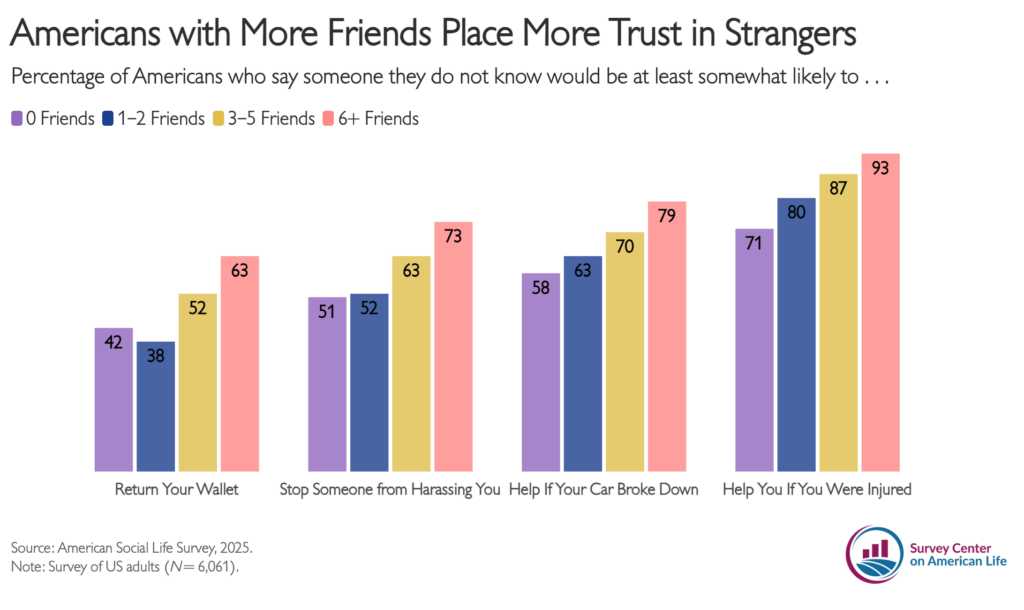July 2, 2025
America’s Cultural Crossroads: Enduring Discontent, Rising Disconnection, and an Uncertain Future

Acknowledgment
The American Enterprise Institute’s Survey Center on American Life is grateful to the John S. and James L. Knight Foundation for its generous support of this research.
Introduction
After the 2024 presidential election, the American public remains largely pessimistic about politics, although partisans have dramatically different views about the country’s direction. Despite Donald Trump’s comfortable margin of victory, neither party is well-regarded by the public, and Trump’s standing with younger voters is not as strong as voting might suggest. The Democrats face their own challenges among left-leaning Americans. Still, the public is somewhat upbeat about their fellow citizens: Most believe that Americans generally treat other people with respect and look out for each other.
The Survey Center on American Life’s new survey reveals that on numerous salient cultural issues, the public is changing course. In the early months of Trump’s second presidency, support for mass deportation of immigrants living in the country illegally is higher than it has been in nearly a decade. Most Americans now support this policy.
American attitudes about gay rights have undergone a significant shift since 2020. Today, most Americans believe the country has done enough to give equal rights to gay and lesbian people. Five years ago, the public was essentially split over whether more should be done to ensure equal rights for gay and lesbian people. The survey also finds growing support among young men for restrictions on pornography and an uptick in support for traditional gender roles.
As the country’s cultural course remains unsettled, the strength of its social networks also appears to be in decline. After the COVID-19 pandemic, the time Americans spent in third places—such as coffee shops, bars, public parks, and other neighborhood spaces—dropped precipitously. Four years later, there are no signs of recovery. Fewer Americans are hanging out in shared public or commercial places than they were six years ago.
Still, social experiences vary widely among the public. Married Americans and those with large numbers of close friends report some of the highest levels of personal satisfaction. When it comes to receiving physical affection, single men’s experience is unique. Fewer than half of single men report that they have received a hug or some other form of physical affection in the past week, far less frequently than single women or married men.
Despite their diminishing levels of social engagement, Americans maintain a reservoir of trust in each other. Most Americans believe strangers would be willing to help them if their car broke down, they were injured, or they were being harassed or threatened in a public place. Americans are less certain that a lost wallet would be returned to them with the money still in it.
Political Pessimism, Mistrust, and Growing Partisan Divisions
Americans have a low regard for elected officials and the two major political parties, and their feelings about how things are going in the country have become more polarized after the 2024 election. But Americans express more optimism about their fellow citizens’ capacity to care for others, ability to treat people with respect, and willingness to abide by federal and state laws.
Americans Are Dissatisfied with How Things Are Going in the US
Few Americans report feeling satisfied with the way things are going in the United States. Only 39 percent of the public say they feel at least somewhat satisfied with what is happening in the country. Meanwhile, more than six in 10 (61 percent) say they are not too or not at all satisfied.
Despite Americans’ negative views about how things are going in the country, they have a somewhat more positive outlook than they did a few years ago. In 2022, fewer than one in four (24 percent) Americans said they felt satisfied with how things were going in the United States.
Views of the country remain sharply polarized, with partisans expressing dramatically different feelings. Seventy-one percent of Republicans report that they are at least somewhat satisfied with the way things are going in the country, compared with only 12 percent of Democrats. For partisans, Trump’s election may have spurred a radical reassessment of the state of the country. One year ago, 17 percent of Republicans and 51 percent of Democrats said they were satisfied with the way things were going in the country.
The Pessimism of College-Educated Women
Americans remain split about the future of the United States. Roughly as many Americans report that they are somewhat or very optimistic as say they feel somewhat or very pessimistic (49 percent vs. 51 percent). Views have remained largely unchanged over the past few years: In 2021, 47 percent of the public felt optimistic about the country’s future, while 53 percent said they were pessimistic.
College-educated women are uniquely pessimistic about the country’s future. Nearly two-thirds (64 percent) of women with a college degree report they are pessimistic about the future of the United States. Most college-educated men (55 percent) also feel pessimistic, although not quite as strongly as women. Not only are college-educated women more pessimistic than most other Americans; they have become markedly more so since Trump’s election. In 2021, nearly half of college-educated women were somewhat or very optimistic about the United States’ future.
Trump-Era Politics: Political Apathy and Mistrust
Widespread Mistrust of Political Officials
Americans have a generally low regard for many of their political institutions, and most say they mistrust elected officials to act in the public interest. Nearly three-quarters (74 percent) of Americans say elected officials mostly want to benefit themselves, while only one in four (25 percent) say officials care more about improving the country.
The belief that elected officials are more focused on their own personal gain than on improving the country is widespread among the public, cutting across lines of education, race, ethnicity, gender, and age. Democrats are especially cynical: Nearly eight in 10 (79 percent) say elected officials are only in it for themselves, a view held by 64 percent of Republicans.
In his recent election, Trump may well have benefited from Americans’ low esteem for public officeholders. Few Americans believe Trump is honest or trustworthy, but many do not believe he is any worse than the average public official. Close to half (47 percent) of Americans say Trump is less trustworthy than most other elected government officials. But collectively, more Americans say he is more trustworthy (33 percent) or no different (20 percent). Even Americans with moderately negative views of Trump—specifically, those with a somewhat unfavorable opinion of him—do not view him as especially untrustworthy. Most (56 percent) say he is no different from the average elected government official.
Rising Disaffection with the Democratic and Republican Parties
A growing share of Americans have become disillusioned with both political parties. Just under one in four (24 percent) Americans have a negative view of the Democratic and Republican Parties. In contrast, 25 years ago, fewer than one in 10 Americans held an unfavorable opinion of both parties.[i]
Although young men swung strongly toward Trump in the latest election, they are uniquely hostile toward the Democrats and Republicans. More than one in three (34 percent) young men say they view both the Democratic and Republican Parties unfavorably. Meanwhile, 26 percent of young women view both parties unfavorably.
Young liberals are especially disillusioned with the Democratic Party. Among young adults who identify as liberal, 37 percent say they have an unfavorable opinion of the Democratic and Republican Parties. Fifty percent view the Democrats favorably. This negative view starkly contrasts with that of older liberals, who generally view the Democrats positively. Nearly eight in 10 liberals age 65 or older have a favorable view of the Democratic Party; only 14 percent have a negative view of both parties.
While the Democratic Party is struggling with younger liberals, Trump has not completely won over younger Republicans. Among those who identify with the Republican Party or lean toward it, older Americans have much more positive views of the current president. Nearly six in 10 (59 percent) Republican seniors have a “very favorable” view of Trump, compared with fewer than half (44 percent) of those under age 30.
Americans Have Mostly Positive Views of Their Fellow Citizens
Overall, Americans have a generally positive view of their fellow citizens. For instance, 57 percent of the public say they have a fair amount or a great deal of confidence that Americans honestly report their full income when paying their taxes. Nearly six in 10 (58 percent) members of the public say they have at least a fair amount of confidence that Americans can work together to solve community problems (58 percent) or that they will generally treat others with respect (59 percent). More than six in 10 (63 percent) say they have a fair amount or a great deal of confidence that Americans will do what they can to help those in need. Two-thirds (67 percent) of the public say they are confident that Americans will obey federal and state laws, although a smaller portion (56 percent) believe this is the case when Americans disagree with those laws.
However, Americans are far less confident that their fellow citizens are willing to compromise on issues important to them. Only 42 percent of the public say they have a fair amount or a great deal of confidence that Americans will compromise on the issues they care about.
Liberals have a far more negative view of the American public than conservatives do. Fewer than one in three (31 percent) liberals believe Americans are willing to compromise on important issues, compared with nearly half (48 percent) of conservatives. Just under half (49 percent) of liberals believe the American people can work together to solve community problems, a view held by nearly two-thirds (64 percent) of conservatives. Only 49 percent of liberals are confident in their fellow citizens’ capacity to treat other people with respect; in contrast, more than two-thirds (68 percent) of conservatives are confident in the American public’s capacity to do this.
The Political Segregation of Young Men and Women
The social world of young women and men is politically distinctive. Compared with young men, young women report far fewer close connections to people who support Trump. More than half (51 percent) of young women report that they have no close friends who are Trump supporters, while about one-third (33 percent) say at least some of their close friends support Trump. In contrast, just over one-third (36 percent) of young men report having no close friends who support Trump, while nearly half (47 percent) say some, most, or all of their close friends are Trump supporters.
Young women are significantly more likely than young men to report that all or most of their close friends are Democrats. Nearly four in 10 (38 percent) young women say this, compared with about one in four (24 percent) young men.
Regardless of how Americans voted—whether they voted for Donald Trump, voted for Kamala Harris, or did not vote—having more close friends who are Trump supporters is linked to holding more favorable views of him. Three-quarters of Trump voters who say all their close friends support the president also say they have a “very favorable” opinion of him. Fewer than half (45 percent) of Trump voters with some close friends who support the president have a very favorable opinion of him.
Among Harris voters, those with some close friends who support Trump are somewhat less likely to have a very unfavorable view of the president than those with none (79 percent vs. 95 percent).
Diminishing Third Places and the Enduring Benefits of Social Connection
Strong social connections continue to be an important element of personal satisfaction, but Americans are spending less time at places that foster these relationships. Those with larger social networks are more trusting and report greater satisfaction with the way their life is going. However, the time Americans are spending in shared public spaces—such as parks, libraries, coffee shops, and bars—is declining.
Neighborhood Friends and Community
There’s a growing movement to encourage people to live near or even with their friends to foster community and social connection. With Americans marrying later and starting families later or not at all, friendship has received greater attention as a way to combat loneliness. But in their capacity to create community, neighborhood friendships are limited.
Only about one in three (36 percent) Americans who have close friends report that a lot or all of them live nearby. Thirty-two percent of Americans say some of their close friends live close by, while 19 percent say only a few close friends live in their neighborhood. Meanwhile, 12 percent of Americans with close friends report that none live close to them.
Notably, having many close friends living nearby does not appear to matter much for how connected people feel to the place where they live or the people in it. Most Americans who say all their close friends live nearby also say they feel closely connected to their neighborhood and the people who live there. But among Americans with only a few close friends living nearby, roughly the same portion (53 percent) say the same.
Americans who have more close friends living nearby are no more likely than those who do not to say their neighbors are generally willing to help each other. Additionally, Americans with many close friends living nearby are not more likely to volunteer, attend a community social function, or organize a local social event.
Third Places and Belonging
Third places—the restaurants, bars, parks, and corner stores that provide opportunities for neighbors to interact in the real world—are strongly associated with feelings of neighborliness and belonging. Not all public and commercial spaces are equally likely to serve as gathering spots or community hubs, but Americans report visiting a few—such as public parks and coffee shops—to connect with their neighbors, colleagues, and friends.
Disappearing Third Places
Roughly five years after the pandemic led to a prolonged closure of many commercial and public places, Americans are still spending less time in bars, restaurants, coffee shops, and parks. More than half (54 percent) of Americans report that they regularly spend time at a coffee shop, bar, restaurant, or park in their community. But 45 percent say they do not have a local place where they spend time regularly. Before the pandemic, two-thirds (67 percent) of Americans reported that they would regularly visit a local place.
College-educated Americans are more likely than those without a four-year degree to report going regularly to a local place, but this practice has significantly declined among both groups. Nearly six in 10 (59 percent) college-educated Americans often spend time at a place in their community, compared with 51 percent of Americans without a four-year degree. In 2019, more than seven in 10 (71 percent) college graduates and 65 percent of Americans who did not graduate from a four-year college or university reported having such a place.
Although fewer Americans today report having a third place, those who do have one still spend considerable time there. More than half (52 percent) of Americans who spend time at a local place report visiting it at least once a week. More than eight in 10 report spending time at a local place at least once or twice a month.
Places That Foster Belonging
Although third places are diverse in their specific form and primary function, a few types serve as the most common gathering spots. Roughly three-quarters of Americans who spend time at a third place describe it as a coffee shop (25 percent), a bar or restaurant (23 percent), or a public park (23 percent). Americans mention libraries, gyms, and even community centers much less often as places they visit regularly.
Third places offer unique opportunities for Americans to spend time with their neighbors and friends. Despite the decline in third places, Americans who still visit them report that they regularly run into people they know there. More than six in 10 (63 percent) Americans who have such a place say that when they spend time there, they usually see people they know.
These regular encounters with neighbors, friends, and acquaintances in shared spaces can foster a sense of belonging and trust. Americans who regularly spend time in a local commercial or public place feel much more closely connected to the people in their neighborhood than those who do not (61 percent vs. 43 percent). The gap is even wider among Americans who regularly see people they know at these places: 70 percent say they feel somewhat or very closely connected to their community and the people who live there.
Having a third place where one regularly runs into people one knows may lead to more positive evaluations of the community as a whole. Among Americans who regularly come into contact with people they know at their third place, 72 percent say they live in a “tight-knit community,” while only half of those with no third place say the same.
Americans feel connection to their communities not only because of the people who live there; the physical space may also play a critical role. Third places provide unique opportunities for neighbors and community members to spend time together in shared spaces. Creating community requires more than assembling a group of people with similar experiences, perspectives, or lifestyles; shared places are also essential.
Friendship and Social Trust
The size of Americans’ social networks is strongly associated with their level of social trust. Put simply, Americans with more robust social connections have more trust than those with fewer or no close friends.
Overall, Americans generally believe that strangers would come to their aid if they needed it, whether they were being harassed, their car broke down, or they became injured. More than eight in 10 (85 percent) Americans believe that strangers would be somewhat or very likely to help them if they were injured in a public place. Almost seven in 10 (69 percent) say people would be at least somewhat likely to help if their car broke down. Sixty-one percent of Americans overall, including two-thirds (67 percent) of women and 56 percent of men, say a stranger would step in to help if they were being harassed or threatened in a public place.
This does not mean Americans completely trust strangers to do the right thing, however. When it comes to having their wallet returned with all the money still in it, the public is more evenly divided. About half (51 percent) of Americans believe this outcome is at least somewhat likely, while roughly as many (48 percent) say it is unlikely.
Americans with more close friends have much higher confidence that people behave fairly in their dealings with others. For instance, nearly six in 10 (59 percent) Americans with no close friends say that most people would try to take advantage of them if given the chance. Americans with at least six close friends are far less likely to express this view—only 29 percent say people would try to take this advantage. Most Americans with more close friends believe people generally try to be fair. Similarly, a majority (54 percent) of Americans with at least six close friends believe that “most of the time people try to help others,” a view shared by only 33 percent of Americans with no close friends.
Americans with broader social networks express greater trust in the beneficence of strangers as well. More than nine in 10 (93 percent) of Americans with at least six close friends believe a stranger would help them if they were injured, a view shared by roughly seven in 10 (71 percent) Americans with no close friends. Similarly, nearly three-quarters (73 percent) of Americans with six or more close friends say a stranger would intervene to help them if they were being harassed. Americans with no close friends are far less confident—only about half (51 percent) believe a stranger would help them out. There is a notable gap in Americans’ confidence about whether a stranger would return their wallet. More than six in 10 (63 percent) Americans with at least six close friends believe their wallet would be returned, but only 42 percent of those with no close friends share this view.

It’s possible that Americans who naturally trust others more find it easier to develop and maintain close relationships, but it’s equally probable that an expansive friend group helps people maintain a higher degree of social trust. Having a large group of close friends—and the concomitant experience of regular socializing—alters people’s expectations about others’ behavior.
Friendship, Social Connection, and Affection
Longitudinal studies have shown that Americans are spending more time by themselves. Modern communication technologies, such as social media, allow people to connect with others even when they are at home alone, but (at least for now) these technologies do not allow people to engage in acts of physical affection or human touch. Sixty-eight percent of Americans say they received some type of physical affection, such as a hug, in the past week. Thirteen percent report receiving some form of physical affection in the past month. Nearly one in five (18 percent) say it has been more than a month since they received any kind of physical affection, including 3 percent who say they have never received physical affection.
Women are generally more likely than men to receive hugs or some other type of affection. Nearly three-quarters (74 percent) of women and roughly six in 10 (62 percent) men say they were hugged or received another type of physical affection in the past week.
When it comes to receiving regular physical affection, single men fare the worst. Fewer than half (45 percent) of single men report that they received a hug or some other form of physical affection within the past week. In contrast, more than six in 10 (61 percent) single women say the same. Among married men and women, acts of affection are much more common. More than eight in 10 (81 percent) married women and more than seven in 10 (72 percent) married men say they have received some form of physical affection in the past week.
The size of Americans’ social networks is closely related to the degree to which they experience physical affection. Americans with more close friends report receiving physical affection more often. Under half of men (45 percent) and just over half of women (53 percent) with no close friends report that they received a hug or some other type of physical affection in the past week. In contrast, more than three-quarters of men (78 percent) and women (86 percent) with at least six close friends report having this experience in the past week.
Americans’ living arrangements are also tied to how frequently they receive physical affection. Americans who live alone report receiving physical affection less often than those with other living arrangements, but this factor may matter more for men than for women. Among those living alone, men are far more likely than women to lack regular physical affection. Fewer than half (48 percent) of men who live by themselves report that they were hugged or received some other type of physical affection in the past week. Nearly two-thirds (64 percent) of women who live alone report receiving a hug or other form of physical affection in the past week.
In general, men’s social circumstances—their relationship status, number of friends, and living situation—appear more closely related to their frequency of receiving physical affection than women’s. But that’s not the only way gender relates to physical affection. Frequency of receiving affection may matter more for men’s sense of well-being than for women’s too. More than half (52 percent) of men who received physical affection in the past week report being very or completely satisfied with how things are going in their life. Among men who say it has been more than a month since they had this experience, only 28 percent report feeling very or completely satisfied.
The gap for women is not quite so stark. Women who received physical affection in the past week are not significantly more likely than those who have not received it to say they feel very or completely satisfied with how things are going (46 percent vs. 35 percent).
Receiving physical affection is closely associated with feeling connected to other people. Americans who received a hug or another form of physical affection in the past week are much more likely to say they often feel close to others than those who have this experience less often. Among Americans who received a hug in the past week, 72 percent say they often or very often feel close to other people. In contrast, only half (50 percent) of those who received a hug sometime in the past month—and only one in four who say they have not received any type of physical affection in the past year—say they often feel close to others.
Friends and Dating
Few Americans who are currently single report having gone on a date recently. Only 15 percent of single Americans, including roughly equal portions of men and women, report having gone on a date in the past month. No group is more likely to have gone on a date than Americans who are in a committed relationship but not married or cohabitating. Almost three-quarters (72 percent) of these Americans report having gone on a date in the past month. In contrast, six in 10 (60 percent) married Americans and just over half (54 percent) of those living with a partner report having gone on a date in the past month.
For singles collectively, a broader social circle is linked to a more active dating life. However, when we examine the genders separately, this pattern holds only for single men. Single women with more close friends are not much more likely to date than those with a smaller network of friends. Rather, among singles with more close friends, it is men who are more likely to report having gone on a date recently than those of the same gender with fewer close social connections. Twenty-seven percent of single men with at least four close friends report having gone on a date in the past month, compared with fewer than one in 10 (9 percent) men with three or fewer close friends. More than two-thirds (68 percent) of single men with three or fewer close friends report not having gone on a date in the past year.
The Power of Personal Relationships
When it comes to feelings of satisfaction, personal relationships matter to Americans far more than politics do. Married Americans report feeling far more satisfied with their personal lives than those who are single—with the pattern similar among men and women. Among married Americans, 53 percent report that they are very or completely satisfied with their personal lives; only 28 percent of single Americans say the same.
However, relationship quality matters. Married Americans who report being less satisfied in their marriages are not any more satisfied with their overall lives than those who are not married at all.[ii] The connection between marital relationship satisfaction and life satisfaction is stronger among women than among men. Although relationship quality matters for both men and women, satisfied marriage is more strongly connected to personal life satisfaction for women than for men.[iii] Marriage is hardly the only relationship connected to feelings of personal satisfaction. Friendship, specifically someone’s number of close friends, is strongly tied to their feeling satisfied with how things are going in their life. Regardless of relationship status, the more close friends someone has, the more likely they are to feel satisfied with their life. A majority (56 percent) of Americans who have at least six close friends report feeling very or completely satisfied with their lives. In contrast, only 37 percent of Americans with one or two close friends—and 28 percent of those with no close friends—report feeling very or completely satisfied.
Friendship matters for married and single Americans. Nearly two-thirds (65 percent) of married Americans with at least six close friends report being very or completely satisfied with their life. Single Americans who have at least six close friends are more than twice as satisfied as those who have none with the way things are going in their life. Notably, single Americans with at least six close friends are not much more satisfied with how their lives are going than are married Americans with no close friends.
A Cultural Course Change
For the past several decades, polls measuring political attitudes and identity have found the country moving largely leftward. Although polls consistently find more Americans identifying as conservative than liberal, younger generations are increasingly adopting left-leaning political views, especially on cultural questions—such as same-sex marriage, premarital sex, racial diversity, and gender roles. However, more recent polling suggests a modest reversal, with younger Americans adopting more conservative positions on certain social issues than they have historically.[iv]
Over the past four years, more Americans have come to embrace the idea that society is better off when men and women engage in pursuits that are aligned with their gender. More than four in 10 (42 percent) Americans agree that society is better off when men and women stick to jobs and tasks to which they are better suited; 56 percent disagree with this view. Four years ago, only 36 percent of Americans agreed that society benefits when men and women pursue gendered work or activities.
Men and women differ modestly on the issue of diverging gender roles, but both have grown increasingly receptive to the idea. Close to half (46 percent) of men say society is better off when women and men engage in activities suited to their gender. Roughly four in 10 (38 percent) women agree.
Young women are among the least likely to affirm this statement—only 29 percent believe that society benefits when men and women engage in activities or work that their gender best equips them to handle. Young men are significantly more likely to support the idea, although well less than half do: 43 percent agree that society is better off when men and women stick to roles they are naturally suited to. Older men are most likely to agree. A majority (56 percent) of men age 65 or older believe well-established gender roles provide a societal advantage.
Rising Support for Mass Deportation
American attitudes on immigration have radically transformed in less than a decade. A majority (54 percent) of Americans favor deporting all immigrants who came to the US illegally back to their country of origin.[v] In 2016, fewer than one in three (32 percent) Americans supported this policy, while nearly two-thirds (66 percent) opposed it.
Views have changed among Democrats and Republicans alike, although there remain sharp divisions between members of the two political parties. More than eight in 10 (81 percent) Republicans favor deporting all immigrants living in the US illegally, compared with only 28 percent of Democrats. In 2016, half of Republicans and 16 percent of Democrats favored mass deportation.
Despite rising support for deportation overall, pronounced divisions persist among different racial groups’ views on the issue. More than six in 10 (61 percent) white Americans favor deporting all immigrants who are living in the country illegally. Support for deportation is much more tepid among black and Hispanic adults—only 44 percent and 40 percent, respectively, favor the policy.
Most Americans Say “We Have Done Enough” on Gay Rights
A decade after the Supreme Court ruled on the legality of same-sex marriage, most Americans believe that the country has done enough to ensure that gay and lesbian people have equal rights with other Americans. Fifty-seven percent of Americans say the country has accomplished this goal, and fewer than four in 10 (39 percent) believe there is more work to do.
Views about gay rights have shifted dramatically in recent years. In 2020, Americans were equally divided over whether the country still needed to make changes to secure equal rights for gay and lesbian people. Half of Americans said the country needed to do more, while just about as many disagreed.
Notably, Americans have become less committed to addressing the challenges faced by gay and lesbian people, even as views of discrimination have remained relatively unchanged. Sixty-two percent of Americans believe gay and lesbian people face a lot of discrimination in American society today. This number is down only slightly from 2020, when 65 percent expressed this view.
More Young Men Want Restrictions on Pornography
Americans remain committed to policies that would limit access to online pornography. Nearly seven in 10 (69 percent) Americans support making internet pornography less accessible, while fewer than one in three oppose such efforts. In 2013, roughly two in three (65 percent) Americans voiced support for policies that would limit the availability of pornography online.
Despite the modest increase in support overall, some Americans have grown far more supportive of restricting pornography. Young men have become much more amenable to reducing access to it. In 2013, young men were divided—about half (51 percent) favored making it more difficult to access pornography online, while just about as many (40 percent) opposed this policy. Today, six in 10 young men say they believe we should make accessing pornography online more difficult.
Men’s views on pornography vary markedly by age, with the youngest and oldest expressing the strongest support for increased restrictions. Close to two-thirds (64 percent) of men under age 25 say they favor making it more difficult to access online pornography. An even greater portion of men age 65 or older express support for increasing restrictions on internet pornography. In contrast, just under half of men between age 25 and 54 support making online pornography more difficult to access.

More Americans Side with Free Expression
The past five years have also witnessed a shift in opinion on the issue of free speech. Today, nearly six in 10 (59 percent) Americans believe that too many people are easily offended by others’ language. Only four in 10 (40 percent) say people should be more careful about their language to avoid causing offense. In 2020, Americans were closely divided over what matters more—nearly half (47 percent) said people needed to be cautious in the language they used for risk of offending others, while only slightly more (52 percent) said people were too easily offended.
Conclusion
At a time of widespread political apathy and distrust, American attitudes are evolving in certain cultural debates—sometimes returning to where they were a few years ago—but the implications of these changes are unclear, and the country’s political trajectory is uncertain. Public support for same-sex marriage remains strong, and most Americans continue to believe abortion should be legal in at least some circumstances. Trust in political institutions has declined for decades, with both political parties unpopular. However, although Americans are spending less time together and many of our public debates are characterized by political acrimony, most Americans still believe that strangers would be willing to lend a hand if they were facing a difficult situation or in a vulnerable position.
About the Author
Daniel A. Cox is the director of the Survey Center on American Life and a senior fellow in polling and public opinion at AEI. Under his leadership, the center performs public opinion and survey research on a variety of topics, including the emerging gender divide among young adults, dating and relationships, and social connection.
Methodology
The survey was designed and conducted by the American Enterprise Institute. Interviews were conducted among a random sample of 6,061 adults (age 18 and older), including all 50 states and the District of Columbia. Interviews were conducted both online using a self-administered design and by telephone using live interviewers. All sample frames used for constructing the AmeriSpeak Panel are probability-based and designed to be representative of the national US household population run by NORC at the University of Chicago. Interviewing was conducted between March 10 and March 28, 2025.
Weighting was accomplished in three separate stages. First, weights developed for all panel members to account for their probability of selection into the sample of panel recruits, panel recruitment nonresponse adjustments, and poststratification adjustments of the recruited panel to match population benchmarks. Sampling weights developed for a study sample selected from the panel to account for their selection probabilities under the sample design. The base weights are a product of the AmeriSpeak Panel Weights and the inverse of selection probabilities associated with sample selection from the panel. Lastly, there are final weights developed for all completed cases of a specific study. The final weights are adjustments of the base weights to address survey nonresponse through a weighting class method. Raking adjustments are then applied to the non-response adjusted weights to align the survey sample to specific population benchmarks. The final weights may be trimmed to reduce the influence of extreme weights on survey estimates.
The use of survey weights in statistical analyses ensures that the demographic characteristics of the sample closely approximate the demographic characteristics of the target population. The margin of error for the survey is +/– 1.75 percentage points at the 95 percent level of confidence. The design effect for the survey is 1.93.
Notes
[i] Pew Research Center, Americans’ Dismal Views of the Nation’s Politics, September 19, 2023, https://www.pewresearch.org/politics/2023/09/19/americans-dismal-views-of-the-nations-politics/.
[ii] “Less satisfied” includes those who say they are “not at all satisfied,” “not very satisfied,” or “somewhat satisfied” with their relationship.
[iii] There is a stronger correlation between life satisfaction and relationship satisfaction among married women than among married men.
[iv] Jeffrey M. Jones, “Social Conservatism in U.S. Highest in About a Decade,” Gallup, June 8, 2023, https://news.gallup.com/poll/506765/social-conservatism-highest-decade.aspx.
[v] Gallup, “Immigration,” https://news.gallup.com/poll/1660/immigration.aspx.







